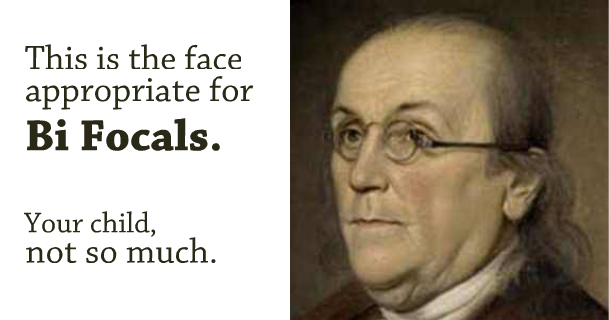
Bi-focals are glasses generally used by individuals who are both nearshighted and farsighted – the older population, for the most part.
There are several variations of these types of lenses, in the most simple terms you get a different prescription in the upper portion of the lens, to deal with distance vision, and another correction in the lower part of the lens, for up-close focus. It is very convenient, as whenever you look down (generally at something up-close), you get the built-in ‘other’ lens to help you see clearly up-close.
People coming from other schools of thought to me, sometimes have their children wearing bi-focals, to accomplish the goal of incorporating a plus lens to help combat myopia.
I am not a fan of this solution.
There are exceptions of course, every child is different, every circumstance is unique to some degree. But if you put me in a room in front of a hundred people and asked if their children should wear bi-focals, my answer would be, ‘no’.
The main reason parents go for bi-focals, is to get the child to actually wear the close-up prescription. It’s the easy way out, rather than immersing the child in a story (see Installment #8), getting participation from the child, building context. One might imagine that if the child wears bi-focals, all that work becomes unnecessary. But, it doesn’t.
I’m all for doing things the most straightforward way. But bi-focals, usually, are not it.
There is the matter of significantly increased prescription complexity, which is one of the no-no’s of the #endmyopia method. But beyond that, the logic of why and how bi-focals are used, that breaks down when we take contemporary use of close-up, and a child’s outlook on the world. This is not the kindly grandfather, sitting in his rocking chair, smoking his pipe, reading the SmallTown Herald. If it were, bi-focals would make sense. His neck is stiff, he glances down at the paper. He can’t see if he were to look through the minus portion of the lens. It works.
But your child is no kindly grandfather, reading the paper. Your child can see just fine, with the minus prescription in the top part of the lens. Your child is also not glancing down, rather looking head on at the bright, shiny display of the iPad. The close-up portion of the prescription doesn’t happen, in this scenario.
I have checked this hundreds of times, with children at the office. Look at the ergonomics, look at which part of the lens their eyes focus through. The bi-focal doesn’t work.
The problem compounds, further.
You think you have the correct lens in front of your child. Your child even, may think he/she is using the right glasses to help with eyesight. But since bi-focals require diligent use of eye position for near vs. far vision, it’s just too complex. It really doesn’t work well, in a lot of cases.
Again, of course, every case is unique. It could work for you.
To see for yourself, you need to observe eye position, when your child is focused up-close. If it is forward, bi-focals won’t work. If it is down, then they do. If it is sometimes one, sometime the other, then we have a whole lot of conflicting focal-correction input, prescription complexity, and we are creating a mess. Let’s try not to do that.
The proper way, is to have simple prescriptions. Building a case for close-up lenses. and enforcing good habits. Convenience, the kindly grandfather would say, is getting us nowhere.
So, forget the bi-focals. It’s a neat idea, but in practice it doesn’t work out.
Next, let’s get going with some of the very helpful things we can do with our new close-up superpowers lenses. I hope you got them! On a side note, I would love to collect some pictures of interesting superpowers frames, your kids wearing them, anything and everything to provide motivations to others following in your footsteps. If you’re open to share, drop me a note in the forum!
Cheers,
-Jake
Session: Audio Track
pending …
Session: Video Stream
pending …
